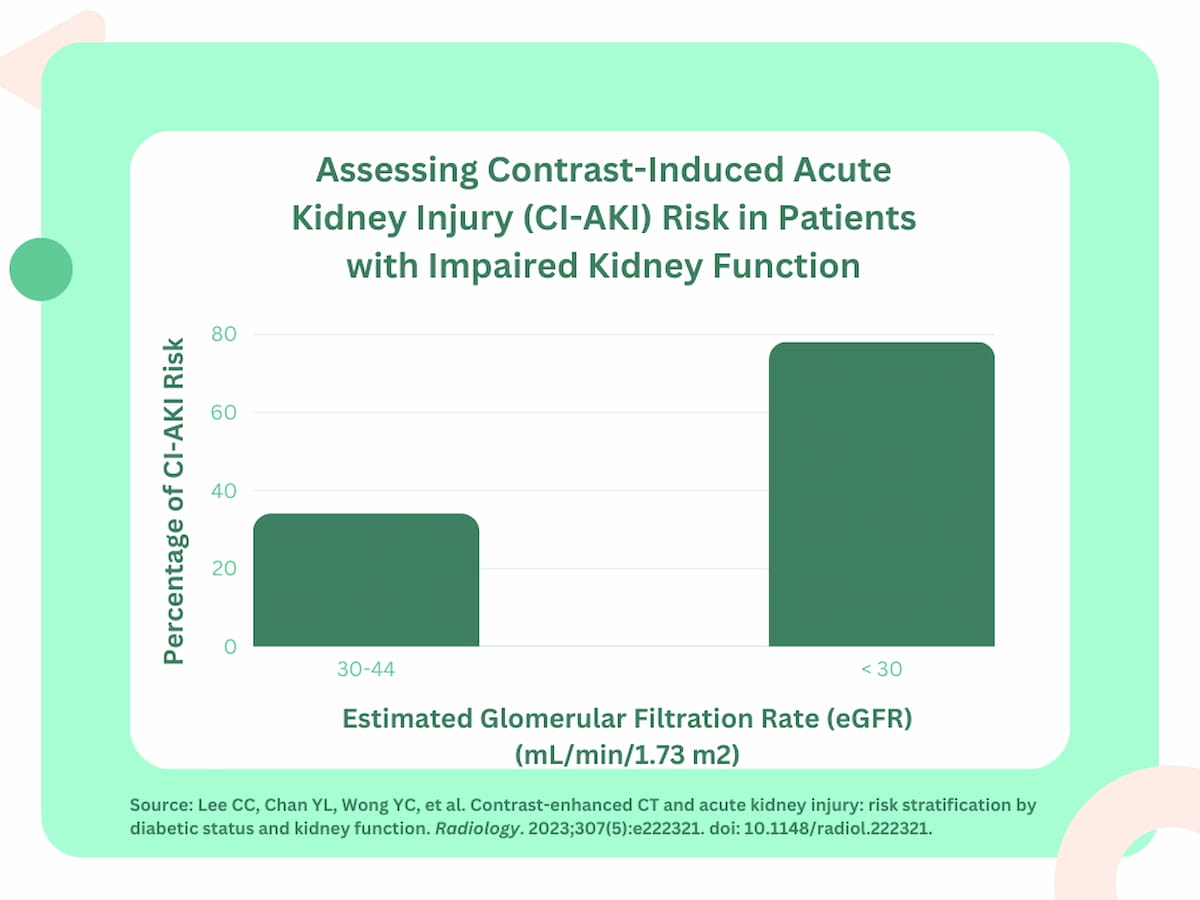- AI
- Molecular Imaging
- CT
- X-Ray
- Ultrasound
- MRI
- Facility Management
- Mammography
What a Large CT Study Reveals About Potential Kidney Injury, Diabetes and Risk Stratification
The use of contrast-enhanced computed tomography (CECT) was associated with more than double the risk of contrast-induced acute kidney injury (CI-AKI) in patients with diabetes and an estimated glomerular filtration rate (eGFR) less than 30 mL/min/1.73 m2 in comparison to the use of non-contrast CT in this population.
Patients with an estimated glomerular filtration rate (eGFR) below 30 mL/min/1.73 m2 are 78 percent more likely to have a contrast-induced acute kidney injury (CI-AKI), according to newly reported retrospective data from over 75,000 patients who had a contrast-enhanced computed tomography (CECT) exam or non-contrast CT.
For the multicenter study, recently reported in Radiology, researchers examined the impact of impaired kidney function, diabetes, and the combination of both upon the risk of CI-AKI in hospitalized patients and emergency department patients having CECT exams. Drawing from seven years of retrospective data from 75,328 patients (mean age of 66), the researchers examined findings from 41,277 CECT exams and 34,051 non-contrast CT exams.
For patients who had CECT, the study authors found that CI-AKI was 34 percent more likely in patients who had an eGFR of 30 to 44 mL/min/1.73 m2 and 78 percent more likely for those who had an eGFR less than 30 mL/min/1.73 m2 are in comparison to patients who had non-contrast CT.
For patients who had CECT, the study authors found that CI-AKI was 34 percent more likely in patients who had an eGFR of 30 to 44 mL/min/1.73 m2 and 78 percent more likely for those who had an eGFR less than 30 mL/min/1.73 m2 are in comparison to patients who had non-contrast CT.

In a subgroup analysis looking at the impact of diabetes for patients with eGFR less than 30 mL/min/1.73 m2 undergoing CECT, the researchers noted that diabetes more than doubled the risk of CI-AKI with an odds ratio (OR) of 2.12 in comparison to those having non-contrast CT. However, the authors still noted a 62 percent higher risk of CI-AKI in patients without diabetes who had less than a 30 mL/min/1.73 m2 eGFR.
“While diabetes mellitus and chronic kidney disease are known risk factors for contrast material-induced AKI (CI-AKI), there have been no large studies evaluating the combined effects of diabetic status and estimated glomerular filtration rate (eGFR) on the odds of CI-AKI,” wrote Tse-Hsuan Su, M.D., M.S., who is affiliated with the Department of Emergency Medicine at Chang Gung Memorial Hospital in Taipei, Taiwan, and colleagues. “In our multicenter retrospective study involving 75,328 hospitalized and emergency department patients, we demonstrated that patients with an eGFR less than 30 mL/min/1.73 m2 had higher odds of developing CI-AKI, regardless of diabetic status.”
However, Su and colleagues pointed out that diabetes was associated with an 83 percent higher risk of CI-AKI in patients with an eGFR of 30 to 44 mL/min/1.73 m2 in comparison to a 14 percent elevated risk of CI-AKI in those without diabetes. For patients with less than a 30 mL/min/1.73 m2 eGFR, diabetes accounted for a 70 percent higher likelihood of 30-day dialysis in comparison to those who did not have diabetes, according to the study authors.
“ … the eGFR threshold for the likelihood of CI-AKI should be adjusted for patients with diabetes, especially for those with an eGFR of 30-44 mL/min/1.73 m2 and less than 30 mL/min/1.73 m2,” emphasized Su and colleagues.
(Editor’s note: For related articles, see “Could Photon Counting Reduce Iodinated Contrast Media for CT Angiography?” and “Reduced-Dose CT Effective for Kidney Stone Imaging.”)
In an accompanying editorial, Matthew S. Davenport, M.D., a past chair of the American College of Radiology’s (ACR) Committee on Drugs and Contrast Media, said consensus statements from the ACR and the National Kidney Foundation maintained that the threshold for elevated CI-AKI risk was an eGFR less than 30 mL/min/1.73 m2. and emphasized that no prophylaxis adjustments should be made “solely based on concomitant diabetes mellitus.”
While acknowledging the study authors’ findings of elevated CI-AKI risks in patients with a combination of diabetes and an eGFR of 30-44 mL/min/1.73 m2 after propensity score matching, Dr. Davenport said further exploration in randomized trials is necessary prior to amending current protocols.
“To my knowledge, (the study authors) are showing for the first time in a propensity-matched design that the presence of diabetes mellitus may remain a relevant covariate for CI-AKI following contrast-enhanced CT,” noted Dr. Davenport, a William Martel Professor of Radiology and Urology, and vice-chair in the Department of Radiology at Michigan Medicine. “However, it is necessary to replicate these results before recommending modifications to existing guidelines.”
Beyond the inherent limitations of an observational study, the researchers conceded possible confounding factors that may have affected reported CI-AKI estimates. Pointing out that only low-osmolar contrast material was utilized for the hospitalized and emergency department patients that comprised the study cohort, the study authors said the study findings may have limited application in other patient settings or facilities that utilize other contrast agents.
FDA Clears AI-Powered Qualitative Perfusion Mapping for Cone-Beam CT
May 6th 2024Reportedly validated in more than 10 clinical trials, the AngioFlow perfusion imaging software enables timely identification of brain regions with cerebral blood flow reduction and those with significant hypoperfusion.
The Reading Room: Racial and Ethnic Minorities, Cancer Screenings, and COVID-19
November 3rd 2020In this podcast episode, Dr. Shalom Kalnicki, from Montefiore and Albert Einstein College of Medicine, discusses the disparities minority patients face with cancer screenings and what can be done to increase access during the pandemic.
Study Reveals Benefits of Photon-Counting CT for Assessing Acute Pulmonary Embolism
April 23rd 2024In comparison to energy-integrating detector CT for the workup of suspected acute pulmonary embolism, the use of photon-counting detector CT reduced radiation dosing by 48 percent, according to newly published research.
